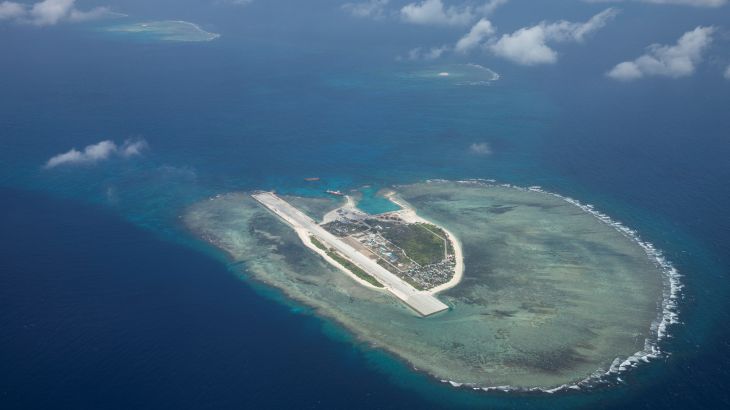US denounces China’s ‘aggressive’ manoeuvre over South China Sea
The US has accused a Chinese military jet of flying too close to its aircraft, causing dangerous turbulence.

The United States has accused a Chinese fighter jet of performing an “unnecessarily aggressive” manoeuvre against one of its aircraft during a flight over the South China Sea, a disputed region of significant strategic importance.
In a written statement on Tuesday, the US Indo-Pacific Command — the armed forces branch overseeing the region — said its aircraft was conducting “safe and routine operations” in “international airspace” when it was intercepted by the Chinese J-16 jet.
Keep reading
list of 3 itemsChina, US in war of words over South China Sea navigation
Chinese military says US ship ‘warned’ away in South China Sea
Its pilot “flew directly in front of the nose of the RC-135, forcing the US aircraft to fly through its wake turbulence”, according to the press release.
“We expect all countries in the Indo-Pacific region to use international airspace safely and in accordance with international law,” the statement added.
#USINDOPACOM Statement on #PRC Unprofessional Intercept: "We expect all countries in the Indo-Pacific region to use international airspace safely and in accordance with international law."
Read more⬇️https://t.co/jeAEg1lHXz pic.twitter.com/AvPKRZHCZB
— U.S. Indo-Pacific Command (@INDOPACOM) May 30, 2023
A video released with the statement shows the inside of the US Air Force plane’s cockpit, as a fighter jet approaches from one side, soaring over the clouds. As it turns and passes in front of the nose of the Air Force plane, the video wobbles from the force of its airflow.
The narrow fly-by and the US’s subsequent statement are the latest tit-for-tat over the South China Sea, where China has made broad territorial claims, covering much of the region.
The US, however, has argued such claims could violate the sovereignty of other countries in the region. One of those countries, the Philippines, brought a petition in 2013 to the Permanent Court of Arbitration in The Hague, Netherlands, to adjudicate the matter.
While China refused to participate in the proceedings, the court ultimately found in 2016 that its claims over the South China Sea had no basis in international law.
In the wake of that ruling, the US has called on China to “cease its provocative behavior” in the South China Sea and confirm “that it is committed to the rules-based maritime order that respects the rights of all countries, big and small”.
But China, the US and its allies continue to patrol the contested waterway and its airspace, which has led to numerous interceptions and near-miss collisions.
In April, for instance, US State Department spokesperson Matthew Miller called on China to “desist from its provocative and unsafe conduct” after a Philippine Coast Guard boat and a Chinese vessel nearly struck one another.
China’s foreign ministry responded that the Philippine boat had “intruded” on its territory in a “premeditated and provocative action”.
And in December, a Chinese plane passed within 3 metres (10 feet) of another US Air Force vehicle in international airspace, barely avoiding a hit.
The latest incident comes as China refused a request to meet with US Defence Secretary Lloyd Austin during the Shangri-La Dialogue Asian security summit in Singapore this week.
But despite the tense relations between the two countries, US President Joe Biden told journalists this month that he predicted a “thaw very soon”.
A new ambassador from China, career diplomat Xie Feng, has recently arrived in Washington, DC.
“We hope that the United States will work together with China to increase dialogue, to manage differences and also to expand our cooperation so that our relationship will be back to the right track,” Feng said on his arrival a week ago.